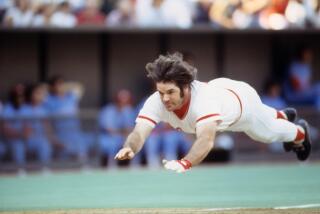Cheaters never prosper -- except in baseball
BASEBALL-WISE, I was educated in the fine arts of booing, interfering with a center fielder’s catch of a fly ball and shrieking curses -- even at the home team -- in that Harvard for hecklers, the zoo-like “bleacher-bums” section above the ivy-covered wall of Wrigley Field, lair of the Chicago Cubs.
Unlike our crosstown rivals, those knuckle-dragging White Sox fans, we usually refrained from jumping onto the diamond to slug a player or coach.
Deep in his cheatin’ heart, I suspect that Derek Zumsteg, author of “The Cheater’s Guide to Baseball,” a cheerfully amoral history of ballpark deception, is more a bozo Sox fan than a chivalrous Cubs fan. Or perhaps he is fond of the corked bat, the spitball and the stolen sign because he’s a devotee of, and Web master for, the sad-sack Seattle Mariners, one of five Major League teams never to have played in a World Series.
If you’re a fan of an expansion team that has had 14 successive losing seasons, crooked gamesmanship might begin to look positively ethical.
Thus, the former Mariners pitching ace and (illegal) spitball hurler Gaylord Perry figures prominently in Zumsteg’s pantheon of villains we love. You have to know something about the strange, dippy aerodynamics of a thrown baseball zipping from mound to batter’s box, precisely 60 feet, 6 inches (not a hundredth of an inch more nor less), to appreciate the exquisite finesse used by those other Picassos of prohibited pitches, Whitey Ford and Don Drysdale, who doctored balls so skillfully that they practically invited TV camera close-ups to catch them at it.
They and countless other corner-cutting mounds men were geniuses at microscopically reconfiguring a baseball (or a bat) with tobacco juice, Vaseline, tiny nicks, sweat, rosin, dust -- anything to bamboozle a batter into swinging at what ain’t there.
As a former sandlot player and current fan (alas, of the perennially losing Cubs), I thought I knew or had practiced most of these baseball crimes. But Zumsteg lists a few I’d never thought of. Take grounds keeping. I hadn’t known that longtime Cleveland Indians groundskeeper Emil Brossard and his two sons made “adjustments to the playing surface of each home game based on what they knew of the other team’s tendencies and the Indians’ lineup.”
With right-handed pull hitters, they’d make the infield play faster near third base by rolling the surface and watering it less. The Philadelphia Phillies ground crew, he writes, “built a third base line that was inclined to favor left-handed bunter Richie Ashburn.”
To slow down base stealers, some teams use sand on the basepaths. Next time you’re at a game, keep an eye on the groundskeeper’s rake. But of course our true blue Dodgers would never cheat, would they?
If the cliche that baseball is a game of inches is true, the whole point of cheating (an ugly word -- how about something more elegant, like “adjustment”?) is to gain unfair advantage without getting caught, having to forfeit or be banned for life like the 1919 Chicago Black Sox eight, whose gambling scandal Zumsteg covers yet again. But when it comes to stealing a manager’s or coach’s signals, delaying a game to wait for rain, psyching out the umpire with time-wasting chest-to-chest arguments and innumerable other shadowy tactics, why that’s just baseball as it’s been practiced for 160 years. Who wants to buck tradition?
Zumsteg, who clearly cherishes the great baseball cheaters, pleads justification. “Baseball has never been a clean sport.... Cheating makes baseball a more colorful, interesting sport, where outlaws can flourish if they’re smart and skilled enough.... They become ... heroes of a kind.” He concludes with this amazing “I-kill-out-of-kindness” defense. “Cheating makes the sport stronger.” And Al Capone gave dollar bills to orphans, and ramblin’, gamblin’ Pete Rose never told a lie.
As if to make up for his lighthearted, instructive approach to foul play, Zumsteg’s chapter on steroids should be required reading for any Little League parent pushing a child too far.
What I miss in Zumsteg’s entertaining manual for baseball delinquents is any serious reference to pitchers throwing murderously inside balls at batters (beaning), runners sliding spikes high into second base to prevent a double play (and, if possible, fracture the baseman’s leg) or other career-ending tricks that have always been part of professional baseball.
Nor does Zumsteg really care to examine the head of this stinking fish: the monopolistic, egomaniacal predator-owners such as the Yankees’ George Steinbrenner, Charlie Finley of the old Athletic A’s and the Marlins’ Wayne Huizenga. And how can he omit Bud Selig, who rules impartially (of course!) as both baseball commissioner and quondam owner of the Milwaukee Brewers. Talk about a stacked deck!
But as Bill Veeck Jr., one of baseball’s few honorable proprietors -- he owned the White Sox, the Cleveland Indians and the St. Louis Browns -- once said, “Baseball must be a great game, because the owners haven’t been able to kill it.”
So let’s play ball! And kill the ump!
*
Clancy Sigal is a screenwriter and author, most recently, of the memoir “A Woman of Uncertain Character.”
More to Read
Go beyond the scoreboard
Get the latest on L.A.'s teams in the daily Sports Report newsletter.
You may occasionally receive promotional content from the Los Angeles Times.










